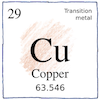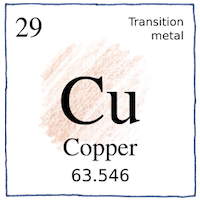Middle East
elements

|
Copper
A copper pendant found in northern Iraq from 8700 BCE. Copper beads buried in Anatolian ruins at Çatalhöyük around 7500 BCE. By this time people knew how to work native copper, how to anneal it, how to smelt it from copper ore and how to cast it using the lost wax method. The Romans mined it in Crete hence our name for it: coper, cuprum, Kuprios, Kupros.
Atomic number 29
People began to depend on copper in the Copper Age, the Chalcolithic, between the Neolithic and the Bronze Age. Copper is associated with Venus and Aphrodite because of its beauty, its use in making mirrors, and its source in Cyprus, sacred to the goddesses. Bronze is an alloy of copper and arsenic or tin to make the metal harder. The earliest copper-tin bronze, from 4500 BCE, has been found in Serbia. Trading of copper and tin influenced the development of culture. Tin ore from Cornwall was traded as far as Phoenicia. Julius Caesar made his coins of brass an alloy of copper and zinc. Octavianus Augustus Caesar made his of an alloy of copper, lead, and tin. The gates of the Temple of Jerusalem were an alloy of copper, silver, and gold. The telescope mirrors of Newton, Herschel, and Parson were speculum, an alloy of copper and one-third tin. Bells are cast of bell metal, an alloy of copper and one-fifth tin, and Buddhist singing bowls are made of bell metal, too, with 23% tin. Lanthanum barium copper oxide was the first material found to be superconducting above the boiling temperature of liquid nitrogen.
Copperness
Aged verdigris of gutters, downspouts, and Miss Liberty, or copper pennies tarnished or shiny copper pipes and wires and the copper bottoms of Mom’s Revere Ware pots have warm associations ember of campfire color of sunset evoking the joy of being curious.



Bronze, copper with one-tenth tin, is typically harder and less brittle than wrought iron, but iron was cheaper to mine and process. Bronze doesn’t rust like iron, but forms a protective surface layer of copper oxide or copper carbonate.
This ancient date represents not when ancient man first discovered copper but the first evidence that of it that modern man discovered.
See also in The book of science:
Readings in wikipedia:
Other readings: